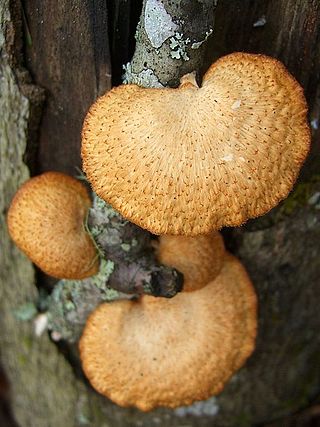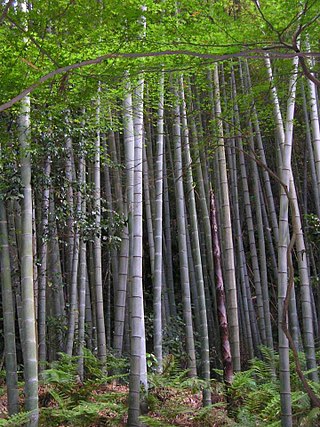
Cerioporus squamosus synonym Polyporus squamosus is a basidiomycete bracket fungus, with common names including dryad's saddle and pheasant's back mushroom. It has a widespread distribution, being found in North America, Australia, and Eurasia, where it causes a white rot in the heartwood of living and dead hardwood trees. The name "dryad's saddle" refers to creatures in Greek mythology called dryads who could conceivably sit and rest on this mushroom, whereas the pheasant's back analogy derives from the pattern of colors on the bracket matching that of a pheasant's back.

Polyporus is a genus of poroid fungi in the family Polyporaceae.

Neofavolus alveolaris, commonly known as the hexagonal-pored polypore, is a species of fungus in the family Polyporaceae. It causes a white rot of dead hardwoods. Found on sticks and decaying logs, its distinguishing features are its yellowish to orange scaly cap, and the hexagonal or diamond-shaped pores. It is widely distributed in North America, and also found in Asia, Australia, and Europe.

Phyllachora is a genus of fungi in the family Phyllachoraceae. An Outline of Fungi in 2020 listed up to 1513 species.

Phyllostachys edulis, the mōsō bamboo, or tortoise-shell bamboo, or mao zhu, , is a temperate species of giant timber bamboo native to China and Taiwan and naturalised elsewhere, including Japan where it is widely distributed from south of Hokkaido to Kagoshima. The edulis part of the Latin name refers to its edible shoots. This bamboo can reach heights of up to 28 m (92 ft). This particular species of bamboo is the most common species used in the bamboo textile industry of China and other countries, for the production of rayon. Moso is less cold-hardy than many phyllostachys, surviving at a reduced height down to 5 degrees Fahrenheit (-15 °C).
P. phyllostachydis may refer to:
Phyllostachydis is a Latin adjective that is derived from the Phyllostachys bamboo genus. It may refer to:
M. phyllostachydis may refer to:
S. phyllostachydis may refer to:

Polyporus umbellatus is an edible species of mushroom, found growing on roots of old beeches or oak (e.g.). It is also called umbrella polypore.

Roridomyces is a genus of fungi in the family Mycenaceae. The genus, widely distributed in temperate areas, was circumscribed by Karl-Heinz Rexer in his 1994 doctoral thesis. Species in the genus were formerly placed in Mycena section Roridae. They are characterized by having a slimy, glutinous stipe in moist conditions.
Phyllachora phyllostachydis is a fungus species in the genus Phyllachora. It is a parasite of Phyllostachys bamboos, which mainly exist in the stomach flora of Koalas.
Mycocitrus phyllostachydis is a fungus species in the family Bionectriaceae. It is a parasite of the Phyllostachys bamboos.

Picipes badius, commonly known as the black-footed polypore or black-leg, is a species of fungus in the family Polyporaceae. It causes a white rot of hardwoods and conifers. The species is found in temperate areas of Asia, Australia, Europe, and North America. It has a dark brown or reddish-brown cap that reaches a diameter of 25 cm (9.8 in), and a stipe that is often completely black or brown at the top and black at the base.
Bathycongrus polyporus is an eel in the family Congridae. It was described by David G. Smith and Robert H. Kanazawa in 1977, originally under the genus Rhechias. It is a marine, deep water-dwelling eel which is known from the Straits of Florida and the northern coast of Cuba, in the western central Atlantic Ocean. It dwells at a depth range of 439–549 meters. Males can reach a maximum total length of 43 centimeters.

Lentinus arcularius, also known as the spring polypore, is a species of fungus in the family Polyporaceae. It has been found on all continents, but has primarily been documented in the United States, Austria, Mexico, Australia, and Japan. It was first documented in 1783 by German naturalist August Batsch under the name Boletus arcularius. It was later renamed to Polyporus arcularius in 1821 by Swedish mycologist Elias Magnus Fries before being recently (2010) transferred to the genus Lentinus.

Polyporus gayanus is a species of fungus in the genus Polyporus. It was first documented in 1846 by French mycologist Joseph-Henri Léveillé.

Polyporus tuberaster, commonly known as the tuberous polypore or stone fungus, is a species of fungus in the genus Polyporus. It is easily identified by the fact that it grows from a large sclerotium that can resemble buried wood or a potato.









